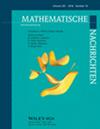通过隐性解链实现一般二项偶阶线性差分方程的临界性
IF 0.8
3区 数学
Q2 MATHEMATICS
引用次数: 0
摘要
在本文中,作者研究了具有两个项的特定不共轭偶阶线性差分方程,并根据它们在正无穷大和负无穷大处的隐式解的性质对它们进行了分类。所描述的主要定理指出,只要特定的二阶线性差分方程是-临界的,所研究的方程就是-临界的。在证明过程中,作者得出了所研究方程的闭式解,其中出现了上述二阶方程的解。此外,为了确定隐性解,作者还通过序列排序将这些解组织成一个线性链,比较了......处的解。本文章由计算机程序翻译,如有差异,请以英文原文为准。
Criticality of general two-term even-order linear difference equation via a chain of recessive solutions
In this paper, the author investigates particular disconjugate even-order linear difference equations with two terms and classify them based on the properties of their recessive solutions at plus and minus infinity. The main theorem described states that the studied equation is -critical whenever a specific second-order linear difference equation is -critical. In the proof, the author derived closed-form solutions for the studied equation wherein the solutions of the said second-order equation appear. Furthermore, the solutions were organized, in order to determine recessive solutions, into a linear chain by sequence ordering that compares the solutions at .
求助全文
通过发布文献求助,成功后即可免费获取论文全文。
去求助
来源期刊
CiteScore
1.50
自引率
0.00%
发文量
157
审稿时长
4-8 weeks
期刊介绍:
Mathematische Nachrichten - Mathematical News publishes original papers on new results and methods that hold prospect for substantial progress in mathematics and its applications. All branches of analysis, algebra, number theory, geometry and topology, flow mechanics and theoretical aspects of stochastics are given special emphasis. Mathematische Nachrichten is indexed/abstracted in Current Contents/Physical, Chemical and Earth Sciences; Mathematical Review; Zentralblatt für Mathematik; Math Database on STN International, INSPEC; Science Citation Index

 求助内容:
求助内容: 应助结果提醒方式:
应助结果提醒方式:


